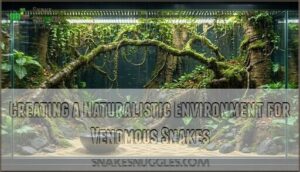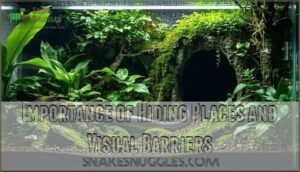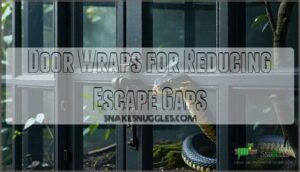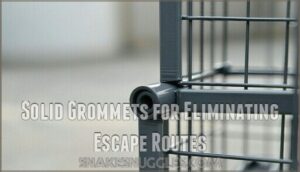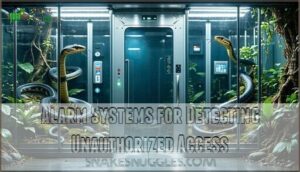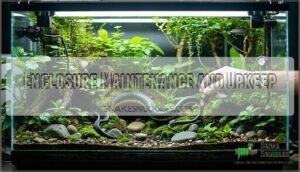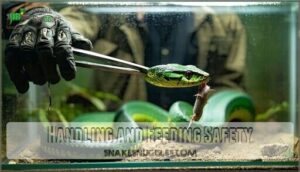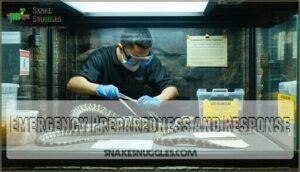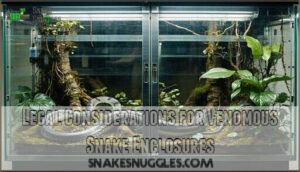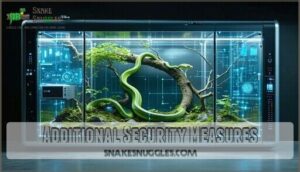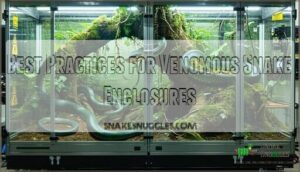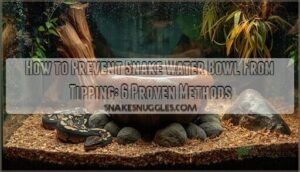This site is supported by our readers. We may earn a commission, at no cost to you, if you purchase through links.
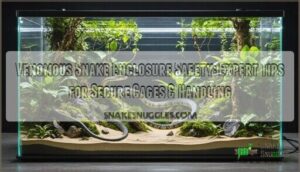
You’ll need escape-proof materials like solid acrylic or glass with secure locking mechanisms that won’t fail when you least expect it.
Your enclosure must have proper ventilation, redundant locks, and zero gaps larger than your snake’s smallest dimension.
Wire locks, door wraps, and solid grommets aren’t optional extras—they’re your insurance policy against disaster.
Temperature and humidity controls keep your snake healthy, while proper lighting helps you spot potential problems before they become emergencies.
Think of each safety feature as another layer between you and a potentially life-threatening situation that could unfold faster than you can blink.
Table Of Contents
- Key Takeaways
- Choosing The Right Enclosure
- Designing a Secure Environment
- Safety Features for Venomous Snake Enclosures
- Enclosure Maintenance and Upkeep
- Handling and Feeding Safety
- Emergency Preparedness and Response
- Legal Considerations for Venomous Snake Enclosures
- Additional Security Measures
- Best Practices for Venomous Snake Enclosures
- Frequently Asked Questions (FAQs)
- What 5 things should you never do when bitten by a venomous snake?
- How to safely handle a venomous snake?
- What not to put in a snake enclosure?
- Are venomous snake cages safe?
- How to prevent venomous snakes from escaping?
- Does save the snakes sell venomous snakes?
- How do you care for a venomous snake in a restraint box?
- How Often Should Venomous Snakes Be Fed?
- What Are the Consequences of Illegal Trading of Venomous Snakes?
- Are Venomous Snakes Legal to Keep in All States?
- Conclusion
Key Takeaways
- Choose escape-proof materials like tempered glass (6mm+ thick) and HDPE plastic with secure tubular cam locks and dual-lock systems—your enclosure’s only as strong as its weakest point.
- Install redundant safety features including wire locks, door wraps, solid grommets, and alarm systems because a single security failure could turn deadly in seconds.
- Maintain proper environmental controls with adequate ventilation, temperature gradients (75-90°F), and humidity monitoring to keep your snake healthy and reduce stress-driven escape attempts.
- Develop comprehensive emergency protocols including a well-stocked first aid kit, antivenom access plans, nearby hospital locations, and regular practice drills—because when envenomation happens, muscle memory saves lives.
Choosing The Right Enclosure
When you’re housing a venomous snake, your enclosure choice can literally be a matter of life and death.
You’ll need materials that won’t crack under pressure and locks that won’t fail when curiosity strikes at 2 AM.
Escape-Proof Materials for Venomous Snakes
When building your venomous snake enclosure, you’ll need materials tougher than Fort Knox.
Your fortress needs walls that won’t crack when danger strikes at midnight.
Tempered glass at least 6mm thick and polycarbonate panels offer 200x stronger impact resistance than standard glass.
HDPE plastic and stainless steel mesh (12-gauge or lower) create escapeproof materials.
You can find various tempered glass options for enclosures.
Seal all joints with high-grade silicone – because even Houdini would struggle with properly sealed snake enclosure security.
Secure Locking Mechanisms for Snake Enclosures
Choose tubular cam locks and dual-lock systems for maximum tamper resistance.
These secure locking mechanisms prevent unauthorized access and escape attempts that could endanger everyone.
For added security, consider different product options to suit specific enclosure needs.
Install locks on all access points—front doors, feeding ports, and maintenance panels.
Quality lock types with material strength guarantee your venomous snake containment stays bulletproof, giving you complete key control.
Importance of Ventilation in Venomous Snake Enclosures
Maintaining proper ventilation isn’t just about fresh air quality—it’s your secret weapon against respiratory issues and mold prevention.
Strategic airflow enables essential gas exchange while managing humidity control and heat dissipation.
Without adequate snake enclosure ventilation, you’re creating a stuffy nightmare that compromises venomous snake enclosure safety.
Smart snake enclosure design incorporates ventilation openings too small for escape but large enough for healthy airflow.
Essential Features for Venomous Snake Cages
Four essential features make venomous snake cages both secure and functional.
Your escapeproof enclosure needs material rigidity through HDPE plastic or tempered glass, plus reliable cage locks for locking security.
Don’t forget ventilation design with perforated aluminum vents and space optimization for your snake’s comfort.
- Tempered glass doors with secure latching mechanisms
- Perforated aluminum vents for proper airflow control
- HDPE plastic construction for durability and snake enclosure security
- Adequate sizing meeting regulatory compliance standards
Designing a Secure Environment
You’ll need to understand your snake’s natural behavior and create an environment that meets its specific needs while maintaining maximum security.
A well-designed habitat reduces stress and escape attempts, making your enclosure safer for everyone involved.
Understanding Venomous Snake Behavior and Habitat Needs
Your snake’s behavior holds the blueprint for safe enclosure design.
Nature doesn’t negotiate—study your snake’s blueprint before building their fortress.
Venomous snake behavior varies dramatically—vipers coil defensively while elapids rear up when threatened.
Most species strike within half their body length, so you’ll need Temperature Gradients from 75-90°F and multiple Hiding Spots in warm and cool zones.
Habitat Mimicry reduces Snake Stress by 60%, preventing aggressive displays.
Environmental Monitoring prevents escape attempts that spike during temperature fluctuations or inadequate habitat needs.
Creating a Naturalistic Environment for Venomous Snakes
Beyond understanding your snake’s behavior, you’ll want to recreate their natural world. Think of it as building a miniature ecosystem that feels like home.
Habitat Enrichment transforms basic enclosures into thriving environments. Substrate Selection should mirror their native terrain—cypress mulch for forest species, sand for desert dwellers.
Water Features provide drinking spots and humidity, while strategic Lighting Needs create natural day-night cycles.
Here’s your naturalistic environment checklist:
- Layer appropriate substrate 2-3 inches deep
- Install full-spectrum UV lighting systems
- Add climbing branches or rock formations
- Position water bowls away from heat sources
Temperature Gradient zones let snakes thermoregulate naturally. Hiding Places reduce stress—one cool side, one warm.
This enclosure design keeps your snake comfortable while maintaining security.
Providing Adequate Temperature and Humidity Control
Your snake’s comfort depends on precise temperature control and humidity control.
Install heating elements with thermostats to create proper temperature gradients.
Use monitoring tools like digital hygrometers to track snake enclosure temperature levels and snake enclosure humidity levels.
Good ventilation prevents stagnant air while maintaining your naturalistic environment.
Think of it as climate control for your scaly roommate.
Importance of Hiding Places and Visual Barriers
Once you’ve balanced temperature and humidity, focus on snake enclosure hiding spots. Your snake needs privacy like you need morning coffee.
Strategic snake enclosure enrichment with caves, logs, and visual barriers creates naturalistic terrariums that reduce snake stress.
This behavioral enrichment through habitat mimicry improves your snake enclosure wellbeing while enhancing snake security and preventing escape attempts.
Safety Features for Venomous Snake Enclosures
When you’re dealing with venomous snakes, the difference between a secure enclosure and a potential disaster often comes down to the safety features you choose.
From wire locks that prevent curious fingers from opening doors to alarm systems that alert you to any unauthorized access, these security measures aren’t just nice-to-haves—they’re your first line of defense against escape attempts.
Wire Locks for Secure Sliding Glass Doors
Wire locks provide three layers of secure snake cage protection for sliding glass doors.
Choose heavy-duty wire gauge options with reinforced steel components for maximum snake enclosure security.
Lock installation takes minutes, while lock maintenance requires monthly checks.
A secure habitat matters for snake safety.
Compare leading brand comparison models or consider alternative locks like magnetic systems to eliminate snake enclosure design flaws completely.
Door Wraps for Reducing Escape Gaps
When choosing door wraps for your venomous snake enclosure, you’re basically installing a backup security system that covers those sneaky gaps where glass meets frame.
These flexible barriers create an additional seal that prevents even the most determined escape artists from finding their way out.
Consider these vital factors:
- Wrap Material Choices: Select corrosion-resistant materials like rubber or specialized plastics that maintain flexibility over time
- Installation Techniques: Verify proper alignment and consistent pressure across the entire door perimeter for maximum effectiveness
- Gap Size Impact: Measure gaps accurately—even quarter-inch openings can become highways for smaller venomous species
Quality door wraps address snake enclosure design flaws while enhancing overall enclosure security and escape prevention.
Solid Grommets for Eliminating Escape Routes
When grommet installation matters most, solid grommets eliminate sneaky escape routes in your venomous snake enclosure.
These durable components seal ventilation holes and cable entry points perfectly. Choose polyethylene grommet materials for longevity, and perform regular grommet inspection to maintain snake enclosure security.
Proper grommet maintenance prevents costly escapes.
Grommet Types Security Benefits
Alarm Systems for Detecting Unauthorized Access
While solid grommets block physical gaps, alarm systems add another layer of herpetarium security.
Modern security measures use smart sensors for real-time monitoring. Proper sensor placement around doors and access points prevents unauthorized entry attempts.
To further enhance security, consider adding wire locks for doors to prevent escapes.
- Remote notifications alert you instantly via smartphone apps
- System integration connects multiple sensors to central monitoring hubs
- Power backup maintains security during outages for 48+ hours
- False alarms minimize with quality magnetic door alarms and calibrated sensitivity
Enclosure Maintenance and Upkeep
You’ll need to stay on top of maintenance to keep your venomous snake’s enclosure safe and secure.
Regular upkeep isn’t just about cleanliness—it’s your first line of defense against potentially deadly escapes.
Regular Cleaning and Disinfecting of The Enclosure
Maintaining a clean habitat isn’t just good housekeeping—it’s your first line of defense against disease and parasites.
Regular snake enclosure cleaning prevents bacterial buildup and mold control issues that compromise your venomous friend’s health and your safety during handling.
| Task | Frequency |
|---|---|
| Spot clean waste removal | Immediately after defecation |
| Water bowl cleaning | Weekly with reptile-safe disinfectant |
| Substrate replacement | Monthly or when soiled |
| Full enclosure disinfection | Quarterly deep clean |
| Equipment sterilization | After each handling session |
Choose reptile-safe disinfectant types like diluted bleach solutions or commercial reptile cleaners.
Proper cleaning frequency and parasite prevention through consistent reptile enclosure maintenance keeps your snake healthy while ensuring reptile safety during your interactions.
Monitoring for Signs of Wear and Tear
Why wait for a crisis when you can prevent one? Material degradation happens gradually, making routine wear inspection essential for your snake’s safety.
Regular habitat checks help you spot problems before they become dangerous escape routes.
Here’s what to watch for during snake enclosure maintenance checks:
- Joint integrity issues like loose seams or separated panels in your snake enclosure materials
- Corrosion prevention needs around metal components and hinges
- Lock functionality problems that could compromise security
- Ventilation obstruction from debris or damaged screening
Think of your snake enclosure inspection like checking your car’s tires—small issues become big problems fast.
Focus on stress points where materials meet, especially around doors and corners where wear concentrates.
Scheduling Regular Enclosure Inspections
Beyond spotting wear and tear, you’ll need a systematic approach. Create an inspection frequency that works—monthly for active setups, quarterly for stable ones.
Your checklist creation should cover locks, ventilation, and structural integrity. A vital aspect of enclosure maintenance involves monitoring humidity levels to guarantee the snake’s health.
Document everything for your security protocol.
| Inspection Focus | Red Flag Signs |
|---|---|
| Lock mechanisms | Loose bolts, worn latches |
| Glass/acrylic panels | Cracks, stress marks |
| Ventilation screens | Bent mesh, gaps |
Regular snake enclosure inspection isn’t just busywork—it’s your safety net. A damaged enclosure won’t announce itself with fanfare.
Performing Repairs and Replacements as Needed
Your enclosure’s Long-Term Durability depends on prompt corrective action when issues arise. Material Degradation happens—catch it early through snake enclosure regular checks.
Quick fixes prevent bigger headaches:
- Check Seal Integrity around doors and ventilation monthly
- Replace worn locks before they fail completely
- Monitor glass or acrylic for stress cracks
- Update weatherstripping when it loses flexibility
- Document repairs to track Hardware Replacement patterns
Damage Prevention beats emergency fixes every time!
Handling and Feeding Safety
When you’re dealing with venomous snakes, every interaction carries serious risk – but the right tools and techniques can keep you safe.
You’ll need specialized equipment and a solid game plan whether you’re feeding your cobra or cleaning your viper’s enclosure, which involves a serious level of risk management.
Using Proper Handling Tools for Venomous Snakes
Proper tools keep you and your snake safe during interactions. Snake hooks remain the gold standard, effectively controlling over 90% of captive venomous species.
Long-handled tongs with padded tips reduce injury rates by 97% during transfers.
- Hook Technique: Use smooth, confident movements to guide snakes without sudden jerks
- Tong Length: Choose 40+ inch tools to maintain safe distance from striking range
- Tube Restraint: Employ acrylic tubes for close inspections and medical procedures
- Spotter Communication: Always work with a trained partner using clear verbal signals
- Bite Prevention: Never rush – patient handling prevents 78% of preventable incidents
Feeding Techniques for Minimizing The Risk of Bites
Feeding your venomous snake requires strategic planning and proper tool usage.
Choose frozen prey that’s appropriately sized – about as wide as your snake’s thickest section.
Use long-handled tongs to maintain safe distance during feeding, never your hands.
Feed according to your snake’s natural feeding frequency schedule.
Always have another experienced handler present during feeding sessions for safety backup.
Safe Handling Procedures for Cleaning and Maintenance
When cleaning venomous snake enclosures, you’ll handle dangerous situations that demand absolute precision.
Always use proper snake handling tools like hooks and tongs to maintain safe distance during routine inspections. Tool sterilization prevents contamination while assistant communication guarantees backup support.
Move slowly to minimize stress – startled snakes strike faster than you can blink. Focus on escape prevention by checking locks and seals during venomous snake safety protocols.
Your snake enclosure maintenance routine should include disinfecting surfaces and inspecting equipment. Remember, handling safety isn’t negotiable when dealing with venomous reptile enclosure maintenance – one mistake could be your last, emphasizing the importance of proper snake handling tools and absolute precision in these venomous snake environments.
Importance of Having a Knowledgeable Assistant Present
Working with a venomous snake isn’t a solo adventure—you’ll need a knowledgeable assistant to guarantee everyone’s safety.
This collaborative care approach means enhanced safety through shared responsibility and bite risk reduction.
Your assistant provides critical backup during handling emergencies, monitors your technique, and confirms proper snake handling tools are ready.
- Enhanced safety through dual oversight and immediate assistance
- Bite risk reduction with someone watching your blind spots
- Handling emergencies becomes manageable with trained backup
- Snake enclosure safety improves when two people verify procedures
- Safe handling tools are better managed with an extra pair of hands
Emergency Preparedness and Response
Even experienced snake keepers can face life-threatening emergencies, so you’ll need rock-solid preparation before your first venomous bite happens.
Smart owners create detailed emergency protocols and practice them regularly, because when adrenaline kicks in, muscle memory saves lives.
Maintaining a Well-Stocked Snakebite First Aid Kit
Beyond proper handling techniques lies the backbone of emergency response: your snakebite first aid kit.
You’ll need antivenom access, proper bandage types, and CPR knowledge ready when seconds matter.
| Component | Purpose | Key Details |
|---|---|---|
| Pressure bandages | Slow venom spread | 10cm wide elastic |
| Antivenom storage | Snake bite treatment | Cool, secure location |
| Emergency contacts | Quick medical response | Poison control numbers |
| PPE supplies | Handler protection | Nitrile gloves, eye protection |
Your kit location should be easily accessible during wound care emergencies—because nobody wants to hunt for supplies while dealing with an angry snake!
Knowing The Location of Nearby Medical Facilities
Before you head out with venomous snakes, map your route to the nearest hospital with antivenom access. Hospital proximity matters—every minute counts during envenomation.
Keep emergency contacts handy and make certain transport planning includes backup routes. Research which facilities stock specific antivenoms for your species.
Don’t assume your local ER has bite protocols; call ahead to confirm their snake bite treatment capabilities and escapeproof enclosures for patient safety.
Developing an Emergency Plan for Snakebite Incidents
Your emergency plan should include immediate first aid protocols, emergency contacts, and antivenom access details.
Document bite symptoms to watch for and create a clear evacuation plan to medical facilities.
Having a solid bite protocol guarantees swift snakebite management when seconds count—because Murphy’s Law loves venomous snake bite situations.
Practicing Emergency Procedures for Swift Response
Once you’ve developed your emergency plan, regular practice transforms theory into muscle memory.
Conduct monthly drills with your team, testing Envenomation Protocols and Antivenom Availability.
Practice First Aid Training scenarios, verify Emergency Contacts work, and rehearse Evacuation Planning routes.
These drills guarantee emergency preparedness becomes second nature when facing a real venomous snake bite incident.
Legal Considerations for Venomous Snake Enclosures
Before you own a venomous snake, you’ll need to navigate a complex web of federal, state, and local regulations that vary dramatically by location.
Many jurisdictions completely prohibit venomous snake ownership, while others require extensive permits, specialized training, and detailed safety protocols that can take months to obtain.
State and Local Laws Governing Venomous Snake Ownership
Mastering venomous snake laws isn’t just about having the right cage—you’ll need to master a maze of regulations before you even think about bringing one home.
Understanding these legal requirements protects both you and your community from potential disasters.
Key legal considerations include:
- Federal Regulations – The Lacey Act prohibits interstate transport of certain venomous species listed as injurious wildlife
- State Laws – 21 states completely ban private ownership, while others require special venomous snake permits through wildlife agencies
- Local Ordinances – Cities and counties often impose stricter rules than states, sometimes requiring neighbor consent or public notification
- Liability Insurance – Many jurisdictions mandate coverage for potential damages, with some requiring policies exceeding $100,000
Snake laws change frequently, so contact your state’s Department of Natural Resources before permit acquisition.
Violating these regulations can result in fines exceeding $5,000 or criminal charges—making legal research your first step toward responsible ownership.
Permit Requirements for Venomous Snake Enclosures
Before obtaining venomous snake permits, you’ll navigate specific regulations requiring detailed safety plans and secure enclosures.
The application process demands age verification, clean wildlife records, and thorough documentation.
Renewal requirements typically occur annually with updated safety protocols.
Interstate transport needs additional permits and regulatory compliance varies substantially by jurisdiction.
Understanding exemptions explained in local snake laws prevents costly mistakes during permit acquisition.
Finding a Qualified Mentor for Guidance
Finding the right mentor can make or break your venomous snake journey.
Look for reptile professionals with proven snake mentorship experience who emphasize responsible ownership and venomous reptile safety.
Your mentor should understand legal ramifications, ethical considerations, and community engagement standards.
They’ll guide you through snake safety training while sharing real-world wisdom about venomous snake care that books can’t teach.
Ensuring Compliance With Regulations and Laws
Once you’ve found the right mentor, you’ll need to master permit acquisition and signage standards.
Research your state’s reptile safety regulations thoroughly—some require detailed safety plans and training certification.
Post proper warning signs meeting inspection protocols standards.
Remember, legal ramifications for non-compliance can be severe.
Your mentor helps navigate snake safety compliance requirements, ensuring you’re not caught off-guard by changing animal safety regulations.
Additional Security Measures
When you’ve invested in quality locks and escape-proof materials, smart technology can provide an extra layer of protection for your venomous snake setup.
Modern alarm systems and sensors offer real-time monitoring that alerts you instantly if something’s amiss, giving you peace of mind whether you’re home or away.
Magnetic Door Window Alarms for Added Security
Magnetic door window alarms provide excellent snake enclosure security through proper Placement Strategies on cage doors.
These sensors detect unauthorized opening, preventing snake escape prevention disasters.
Choose models with adjustable Alarm Sensitivity to minimize False Alarms from vibrations.
Quality units offer extended Battery Life and System Integration capabilities, making them essential snake enclosure safety measures alongside traditional snake enclosure locks.
Geeni Smart Door Window Sensors for Snake Owners
While magnetic alarms provide basic detection, you’ll want something smarter for snake enclosure security.
Geeni Smart Door Window Sensors deliver real-time notifications to your phone within three seconds of any enclosure breach.
- Sensor Installation: Mount easily on glass or acrylic surfaces without drilling
- Battery Life: Operates 10-18 months before replacement needed
- Connectivity Issues: Maintains 98% accuracy within 50 meters of Wi-Fi
- Integration Options: Works with Alexa and Google Home for voice alerts
Customizing Your Snake Cage for Maximum Security
Beyond smart sensors, you’ll need custom modifications for bulletproof snake enclosure security.
Modified latches with reinforced mechanisms prevent clever escape artists from working their way out.
Custom baffles create maze-like barriers that confuse even determined snakes.
Here’s your security upgrade roadmap:
| Security Feature | Purpose |
|---|---|
| Modified Latches | Prevent manipulation by strong snakes |
| Custom Baffles | Create confusing escape routes |
| Secondary Barriers | Double protection at access points |
| Smart Technology | Real-time monitoring and alerts |
Secondary barriers work like insurance policies – when one fails, another kicks in.
Smart technology integration lets you monitor your secure snake cages remotely.
Think of it as building Fort Knox for your scaly friend.
These snake enclosure design features transform basic setups into maximum-security facilities, ensuring your reptile enclosure security rivals professional installations.
Bedding and Accessories for a Secure Snake Cage
While cage customization provides security, your substrate and accessories choices matter just as much.
Use substrate options like aspen shavings or cypress mulch for Substrate Security. Install escape-proof bowls and secure Water Security features.
Add Secure Plants and hiding enrichment elements. Proper Heat Placement prevents burns.
Regular use of full-spectrum bulbs aids in their metabolic health. Remember, smart snake enclosure accessories keep everyone safer!
Best Practices for Venomous Snake Enclosures
You can’t afford to cut corners regarding venomous snake enclosures – one small oversight could turn your fascinating hobby into a dangerous situation that puts everyone at risk.
Following proven best practices isn’t just about keeping your snake healthy and secure, it’s about ensuring you can sleep soundly knowing your scaly friend is safely contained.
Prioritizing Snake Safety and Well-being
Your snake’s wellbeing comes first in every decision you make. While security systems protect against escapes, your focus should center on creating conditions that prevent stress-driven escape attempts altogether.
Ethical Breeding practices promote healthier animals with better temperaments. Safe Handling techniques protect both you and your snake during necessary interactions. Habitat Enrichment reduces boredom and stress that can lead to problematic behaviors.
Here’s how you’ll maintain prime snake wellbeing:
- Practice Stress Reduction through consistent routines and minimal disturbances
- Provide species-appropriate environmental conditions and hiding spots
- Implement Community Education to promote responsible reptile safety measures
- Schedule regular health assessments with qualified veterinarians
- Maintain detailed records of behavior, feeding, and environmental conditions.
Knowing how to recognize defensive snake postures is also vital for safety.
Importance
Proper venomous species containment isn’t just good practice—it’s essential for public safety.
Your reptile enclosure security directly impacts snake well-being through controlled environment conditions and health monitoring.
Strong animal enclosure security prevents escapes, protecting both your community and your serpent.
Think of reptile security as insurance: you’ll appreciate having it when things go sideways.
Frequently Asked Questions (FAQs)
What 5 things should you never do when bitten by a venomous snake?
Like fighting a dragon with bare hands, don’t cut the wound, apply ice, use tourniquets, suck out venom, or take aspirin.
Instead, stay calm, remove jewelry, keep the bite below your heart, and get to a hospital immediately.
How to safely handle a venomous snake?
Never handle venomous snakes directly – use hooks, tongs, and transfer tubes instead. Always have a trained spotter present, wear protective gear, and keep emergency contacts readily available.
What not to put in a snake enclosure?
One handler learned the hard way when cedar shavings caused his cobra respiratory distress.
You shouldn’t use cedar or pine shavings, glass decorations with sharp edges, or toxic plants in your enclosure.
Are venomous snake cages safe?
Venomous snake cages can be safe when properly designed with escape-proof materials, secure locks, adequate ventilation, and proper handling protocols by trained professionals.
How to prevent venomous snakes from escaping?
Just like a bank vault needs multiple locks, you’ll want several security layers.
Use tempered glass with secure locks, proper ventilation that’s too small for escape.
Regular inspections, and always maintain secondary containment barriers around the room.
Does save the snakes sell venomous snakes?
You’re checking on a conservation organization, not a reptile dealer.
Save The Snakes is a 501(c)(3) nonprofit dedicated to snake conservation, education, and research.
They don’t sell snakes—they protect them through training programs and community outreach, which is a key part of their education efforts.
How do you care for a venomous snake in a restraint box?
Approximately 95% of venomous snake bites occur during handling procedures.
You’ll minimize stress by keeping restraint time under 10 minutes, ensuring proper ventilation, maintaining appropriate temperature, and avoiding unnecessary movement while the snake’s secured.
How Often Should Venomous Snakes Be Fed?
Adult venomous snakes typically eat every 7-14 days, while juveniles need feeding every 5-7 days.
You’ll adjust frequency based on your snake’s species, age, and body condition.
Monitor weight to verify you’re not overfeeding.
What Are the Consequences of Illegal Trading of Venomous Snakes?
Illegal trading can land you in federal prison, facing hefty fines and criminal charges. You’ll lose permits, face lawsuits if someone gets hurt, and damage the reptile community’s reputation forever.
Are Venomous Snakes Legal to Keep in All States?
No, venomous snakes aren’t legal everywhere.
Like traversing a minefield, you’ll find different rules across states, counties, and cities.
Contact your local DNR first—some places ban them completely while others require special permits.
Conclusion
Think of a bank vault—it’s only as secure as its weakest point.
Your venomous snake enclosure safety depends on the same principle. Every component from escape-proof materials to redundant locks must work flawlessly together.
Regular maintenance checks aren’t just good practice—they’re critical for preventing the one failure that could change everything.
Remember, you’re not just protecting your snake; you’re safeguarding everyone around you from a potentially deadly encounter.


